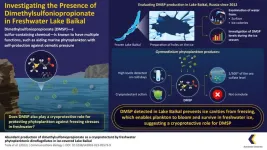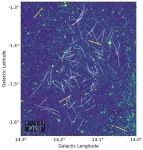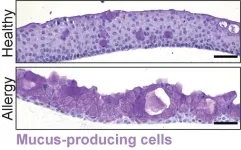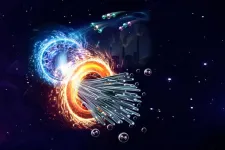Exploring dimethylsulfoniopropionate production by freshwater phytoplankton in lake Baikal
Study reveals that freshwater phytoplankton that bloom in Lake Baikal produce this sulfur-containing chemical abundantly to survive in freshwater ice
2024-01-11
(Press-News.org)
Phytoplankton or microalgae found in the ocean are often known to produce a sulfur-containing chemical called dimethylsulfoniopropionate (DMSP). This organic molecule breaks down to release a strong but sweet-smelling gas called dimethyl sulfide (DMS), which plays a major role in the formation of cloud condensation nuclei and is also associated with the smell of the sea. More importantly, DMSP acts as an osmolyte and thus protects the phytoplankton against the osmotic pressure created by saline water.
Scientists have, however, hypothesized that zwitterionic DMSP—an ion containing both positive and negatively charged functional groups—must also have a role beyond osmotic regulation. Past studies have shown that marine algae in colder oceans produce more DMSP than those found in warmer oceans. Moreover, studies have also revealed that the concentration of DMSP in the ocean decreases as the seasonal temperature rises. Conversely, the abundance of DMSP increases at low temperatures. This could mean that DMSP plays a cryoprotective role for the survival of planktons. In other words, it can act as a substance that protects biological material from damage on being exposed to stresses such as freezing temperatures.
With the curiosity to decipher the cryoprotective role of DMSP for marine algae, a team of researchers from Kumamoto University and Limnological Institute, Russian Academy of Sciences, led by Professor Kei Toda investigated the presence of DMSP in Lake Baikal in Russia, the world’s clearest freshwater lake. Since 2012, the team has been tracking seasonal variations in phytoplankton and DMSP concentration in the ice-covered Lake Baikal. The results of this decade-long study were recently published in Communications Biology on 24 November 2023. “During one of our previous studies, local people reported DMS-like odors from the lake during the ice-melting season. Pollution was an unlikely source, so the other factor could be the conversion of DMSP by the phytoplankton to DMS. Since freshwater algae do not need osmolytes like their marine counterparts do, this piqued our interest to explore its role further,” reveals Prof. Toda.
The team conducted eight expeditions to the Baikal Lake since 2012 to search for phytoplankton production and analyzing DMSP and related chemicals. To analyze DMSP levels, the researchers dug two ice holes of about 70 cm in diameter in the lake during the spring season (around March). They obtained water samples daily from the surface of the lake and from within the ice colonies where the phytoplankton Gymnodinium baicalense bloomed during spring. The team found that the Gymnodinium in the ice colonies produced DMSP and released it into the water during the ice-melting season. Their analysis showed that DMSP concentrations were higher on cold days and lower when temperatures were higher than the freezing point.
Phytoplankton use the sulfur atom from the sulfate ions present in seawater to produce DMSP. The results of this study showed that despite the sulfate concentration in Lake Baikal being 1/500th of the concentration found in seawater, the freshwater plankton Gymnodinium effectively used their limited sulfur resource to synthesize DMSP in their cells and survived in freshwater ice.
The observations and the analysis carried out since 2012 validated the role of DMSP as a cryoprotectant for freshwater algae. “Our results can be further verified by culture experiments at different temperatures and by identifying the genes responsible for DMSP production by freshwater algae,” points out Prof. Toda, on being asked about the possible future direction of this line of research. While the production of DMSP by marine plankton for coping up with osmotic pressure was known, this study is the first to confirm the production of DMSP by freshwater planktons, which do not require osmotic adjustments.
Overall, the findings of this research lay a solid groundwork for further exploration of DMSP production by algae and their functions in other ecosystems such as boreal lakes, glaciers, and alpine snow!
About Professor Kei Toda
Dr. Kei Toda is a Professor of Analytical Chemistry at the Department of Basic Research at Kumamoto University, Japan. Prior to this, he was a postdoctoral researcher at Texas Tech University, USA. Dr. Toda has also served as a visiting professor at the Department of Agricultural Science, Aarhus University, Denmark. He has over 130 publications in the fields of environmental chemistry, analytical chemistry, water analysis, and mass spectrometry. Dr. Toda and his team are currently working on analyzing concentrations and spatial and time variations of chemical compounds in water, soil, plant, and atmosphere to shed light on different environmental phenomena.
END
[Attachments] See images for this press release:


ELSE PRESS RELEASES FROM THIS DATE:
2024-01-11
A team of astronomers including those from the University of Tokyo created the first-ever map of magnetic field structures within a spiral arm of our Milky Way galaxy. Previous studies on galactic magnetic fields only gave a very general picture, but the new study reveals that magnetic fields in the spiral arms of our galaxy break away from this general picture significantly and are tilted away from the galactic average by a high degree. The findings suggest magnetic fields strongly impact star-forming regions which means they played a part in the creation of our own solar system.
It might come as a surprise to ...
2024-01-11
Researchers have identified a 3D fragment of fossilized skin that is at least 21 million years than previously described skin fossils. The skin, which belonged to an early species of Paleozoic reptile, has a pebbled surface and most closely resembles crocodile skin. It’s the oldest example of preserved epidermis, the outermost layer of skin in terrestrial reptiles, birds, and mammals, which was an important evolutionary adaptation in the transition to life on land. The fossil is described on January 11 in the journal Current Biology along with several other specimens that were collected from the Richards Spur ...
2024-01-11
The Organoid group at the Hubrecht Institute produced the first organoid model of the human conjunctiva. These organoids mimic the function of the actual human conjunctiva, a tissue involved in tear production. Using their new model, the researchers discovered a new cell type in this tissue: tuft cells. The tuft cells become more abundant under allergy-like conditions and are therefore likely to play a role in allergies. The organoid model can now be used to test drugs for several diseases affecting the conjunctiva. The study will be published in Cell Stem Cell on 11 January 2024.
Our eyes produce tears to protect themselves from injuries and ...
2024-01-11
A new species of tyrannosaur from southern North America that may the closest known relative of Tyrannosaurus rex is described in a study published in Scientific Reports.
Sebastian Dalman and colleagues identified the new species — which they have named Tyrannosaurus mcraeensis — by examining a fossilised partial skull, which was previously discovered in the Hall Lake Formation, New Mexico, USA. Although these remains were initially assigned to T. rex and are comparable in size to those of T. rex (which was up to 12 metres long), the authors propose that they belong to a new species due ...
2024-01-11
MIAMI, FLORIDA (EMBARGOED UNTIL JAN. 11, 2024, at 11 AM EST) – Certain cancers are more difficult to treat because they contain cells that are highly skilled at evading drugs or our immune systems by disguising themselves as healthy cells.
Glioblastoma, for example, an incurable brain cancer, is characterized by cells that can mimic human neurons, even growing axons and making active connections with healthy brain neurons. This cancer is usually deadly – average survival time is just over one year from diagnosis ...
2024-01-11
A new study led by researchers from the UCLA Health Jonsson Comprehensive Cancer Center shows that using high doses of radiation while integrating an ablative radiotherapy technique called stereotactic ablative radiotherapy (SABR) concurrently with chemotherapy is safe and effective in treating people with locally advanced non-small cell lung cancer that is not suitable for surgery.
Based on mid-treatment response, researchers found the combination treatment, which involves a second radiation plan to personalize a boost for the last third of radiation treatments, is a viable and promising option that helps reduce the risk of toxic side effects and having the cancer ...
2024-01-11
Whether picking up a small object like a pen or coordinating different body parts, the cerebellum in the brain performs essential functions for controlling our movement. Researchers at the Institute of Science and Technology Austria (ISTA) investigated how a crucial set of synapses between neurons within it functions and develops. Their findings have now been published in the journal Neuron.
Even if you do not think about it, every day you are using the intricate circuits of neurons in your brain to perform astonishingly delicate movements with your body. One essential unit in this is the cerebellum playing a key role in fine motor control, coordination, and timing.
“Every ...
2024-01-11
UPTON, NY—Scientists at the U.S. Department of Energy’s (DOE) Brookhaven National Laboratory and Columbia University have developed a way to convert carbon dioxide (CO2), a potent greenhouse gas, into carbon nanofibers, materials with a wide range of unique properties and many potential long-term uses. Their strategy uses tandem electrochemical and thermochemical reactions run at relatively low temperatures and ambient pressure. As the scientists describe in the journal Nature Catalysis, this approach could successfully lock carbon away in a useful solid form to offset or even achieve negative carbon emissions.
“You can put the carbon nanofibers ...
2024-01-11
About The Study: The findings of this study of 6,101 adult cancer survivors suggest that substance use disorder (SUD) prevalence is higher among survivors of certain types of cancer; this information could be used to identify cancer survivors who may benefit from integrated cancer and SUD care. Future efforts to understand and address the needs of adult cancer survivors with comorbid SUD should prioritize cancer populations in which SUD prevalence is high.
Authors: Devon K. Check, Ph.D., of the Duke University School of Medicine in Durham, North Carolina, is the corresponding author.
To access the ...
2024-01-11
About The Study: In this study of patients diagnosed with head and neck cancer from 2017 to 2020 in the U.S., the incidence of localized head and neck cancer declined during the first year of the pandemic. A subsequent increase in advanced-stage diagnoses may be observed in later years.
Authors: Nosayaba (Nosa) Osazuwa-Peters, B.D.S., Ph.D., M.P.H., C.H.E.S., of the Duke University School of Medicine in Durham, North Carolina, is the corresponding author.
To access the embargoed study: Visit ...
LAST 30 PRESS RELEASES:
[Press-News.org] Exploring dimethylsulfoniopropionate production by freshwater phytoplankton in lake Baikal
Study reveals that freshwater phytoplankton that bloom in Lake Baikal produce this sulfur-containing chemical abundantly to survive in freshwater ice







